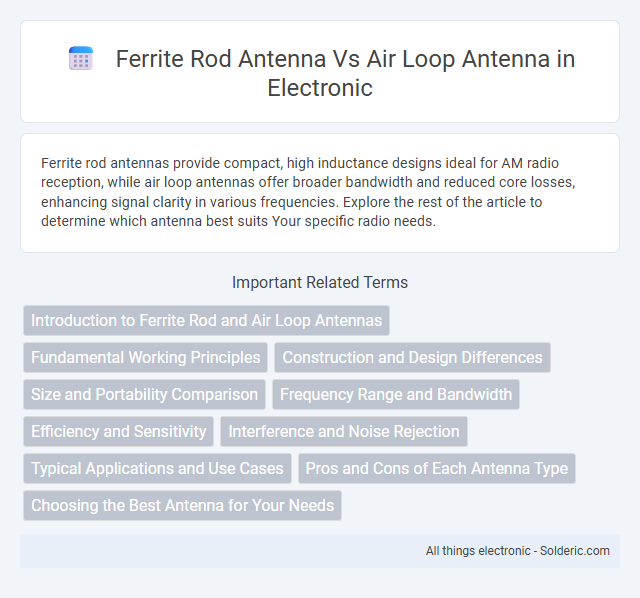Ferrite rod antennas provide compact, high inductance designs ideal for AM radio reception, while air loop antennas offer broader bandwidth and reduced core losses, enhancing signal clarity in various frequencies. Explore the rest of the article to determine which antenna best suits Your specific radio needs.
Comparison Table
| Feature | Ferrite Rod Antenna | Air Loop Antenna |
|---|---|---|
| Core Material | Ferrite Rod (magnetic core) | No core, air coil |
| Size | Compact and small | Larger, bulky |
| Signal Reception | Strong for AM radio frequencies | Good for low-frequency and VLF |
| Directionality | Highly directional | Moderately directional |
| Noise Immunity | Better noise rejection due to core | Lower noise immunity |
| Applications | AM radios, compact receivers | Longwave, VLF receivers, experimental setups |
| Construction Complexity | Simple with ferrite rod and coil | More complex coil winding |
| Cost | Low cost | Moderate to high cost |
Introduction to Ferrite Rod and Air Loop Antennas
Ferrite rod antennas utilize a magnetic core made of ferrite material to concentrate and enhance low-frequency magnetic fields, resulting in improved signal reception for AM radio bands. Air loop antennas consist of wire loops without a magnetic core, relying solely on the magnetic field induced by radio waves, often used for higher frequencies and directional gain. The ferrite rod's compact size and sensitivity make it suitable for portable receivers, while air loop antennas offer broader bandwidth and are frequently employed in specialized communication setups.
Fundamental Working Principles
Ferrite rod antennas rely on high magnetic permeability cores to concentrate magnetic flux, enhancing signal induction in AM radio frequency bands by increasing inductance and sensitivity. Air loop antennas function through electromagnetic induction in a coil of wire, with no magnetic core, relying on the area of the loop and the number of turns to capture the magnetic component of radio waves, making them more effective at higher frequencies. The fundamental difference lies in material properties where ferrite rods amplify magnetic coupling, while air loops depend solely on geometric factors to optimize signal reception.
Construction and Design Differences
Ferrite rod antennas feature a ferrite core wrapped with wire coils, enhancing magnetic field concentration for improved signal reception, especially in AM radio frequencies. Air loop antennas consist of wire loops with no magnetic core, resulting in a larger, more open design that offers better performance at higher frequencies and reduced core losses. Your choice depends on size constraints and frequency range, with ferrite rods excelling in compact setups and air loops providing broader bandwidth capabilities.
Size and Portability Comparison
Ferrite rod antennas are compact and lightweight, making them highly portable and ideal for handheld or small radio devices. Air loop antennas generally require a larger physical size to achieve comparable sensitivity, often resulting in less portability and bulkier setups. The compactness of ferrite rod antennas allows easy integration into devices without compromising performance in limited space environments.
Frequency Range and Bandwidth
Ferrite rod antennas excel in lower frequency ranges, typically from 100 kHz to 30 MHz, offering narrow bandwidth optimized for AM and longwave reception. Air loop antennas cover a wider frequency range, from 500 kHz up to 30 MHz or higher, providing broader bandwidth suitable for shortwave and medium wave bands. The magnetic permeability of ferrite rods enhances sensitivity at low frequencies, while air loops deliver improved performance in higher frequency bands due to their larger physical size and lower losses.
Efficiency and Sensitivity
Ferrite rod antennas typically offer higher sensitivity in AM radio reception due to their concentrated magnetic core, which enhances signal strength and efficiency in compact designs. Air loop antennas provide broader bandwidth and lower noise levels but often require larger physical sizes to match the sensitivity of ferrite rods. Your choice depends on prioritizing compact efficiency with ferrite rods or wider frequency response with air loops.
Interference and Noise Rejection
Ferrite rod antennas excel in interference and noise rejection due to their high magnetic permeability, allowing them to efficiently concentrate magnetic fields and reduce electromagnetic interference from surrounding sources. Air loop antennas, while simpler in design, generally pick up more broadband noise as they lack the ferrite core's filtering effects, making them less effective in noisy environments. Optimizing coil turns and loop orientation can improve air loop performance, but ferrite rod antennas remain superior for rejecting unwanted signals in urban or industrial settings.
Typical Applications and Use Cases
Ferrite rod antennas excel in AM radio receivers and portable communication devices due to their compact size and efficient magnetic field reception, making them ideal for indoor and low-power applications. Air loop antennas are preferred in high-frequency radio transmitters and receiving systems, where their larger size and directional properties enhance signal clarity and range for outdoor or stationary setups. Your choice depends on the specific frequency range, sensitivity requirements, and physical installation constraints of your application.
Pros and Cons of Each Antenna Type
Ferrite rod antennas excel in compactness and strong signal reception for medium wave frequencies but suffer from directional sensitivity and limited bandwidth. Air loop antennas offer broader frequency range and better noise rejection, especially for longwave and shortwave signals, though they are bulkier and less effective for low-frequency reception. Choosing between these antennas depends on application requirements such as space constraints, frequency range, and desired signal clarity.
Choosing the Best Antenna for Your Needs
Ferrite rod antennas excel in compact designs and strong magnetic field reception, making them ideal for portable AM radio applications where signal sensitivity in limited space is crucial. Air loop antennas offer broader frequency range and better performance in reducing interference, suitable for situations demanding higher fidelity and outdoor installation. Evaluating your environment and specific frequency requirements ensures you select the best antenna for your radio reception needs.
ferrite rod antenna vs air loop antenna Infographic

 solderic.com
solderic.com